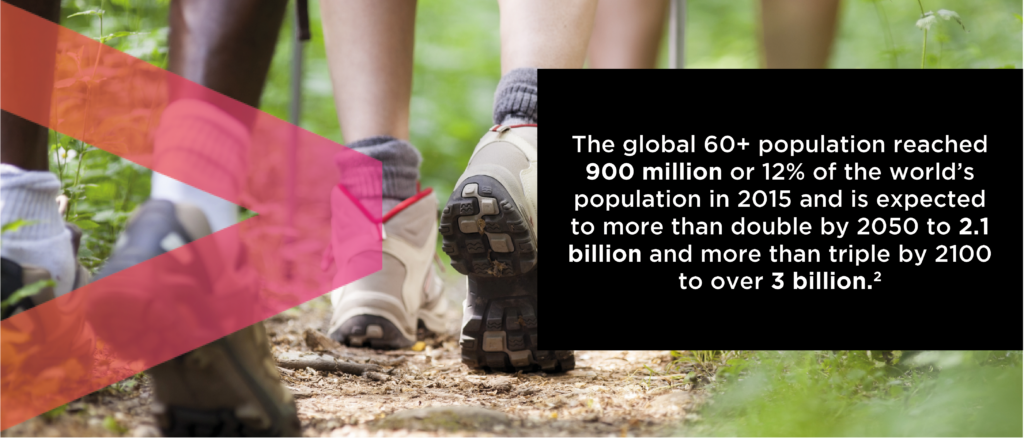The increase in longevity is a human triumph and an irrevocable trend affecting almost everything in our lives, in our society, and the way we do business. Companies are rapidly acknowledging that older consumers are more active, adventurous, and tech-savvy than they are typically given credit for. In the meantime, younger generations are adopting a long-term view of their financial, emotional and physical wellbeing, prioritising healthier lifestyles, flexible work environments and embarking on securing their financial future earlier in life than their parents did. The challenge for investors now, is to identify those companies whose products and services are well placed to create a meaningful connection with the ageing consumers and capture the changing behaviour of generations which will increasingly live to celebrate their centennial birthdays. Over the course of the past two centuries, we’ve seen life expectancy in high income countries increase by two to two-and-a-half years for every decade that’s passed and in recent decades this has been driven by extending the life spans of older people rather than reducing mortality in the early and the middle years of life. It is quite remarkable that in developed markets – a child born today has a better than 50% chance of living to more than 100 (1).
The social and economic implications of ageing populations are becoming increasingly apparent. The global 60+ population reached 900 million or 12% of the world’s population in 2015 and is expected to more than double by 2050 to 2.1 billion and more than triple by 2100 to over 3 billion (2). Populations in the US, Europe, and Japan are ageing more rapidly than ever before. The UN is predicting that a quarter of the world’s over 60s, 500mn people, will reside in China come 2050. This poses several challenges such as declining working-age populations and widening savings gap which pressures the governments around the world to increase statutory retirement age and encourage personal savings. Rising healthcare costs is another certainty; in the US healthcare spending doubles at 65 and quadruples at 85 (3). The changing demand drivers within the economy linked to products and services for older people will continue to present opportunities, especially when one considers that around two thirds of all US wealth is in the hands of the over 55 year olds, a demographic that currently accounts for a third of the population (4). Healthcare, financial services, housing, travel and leisure, education are just some examples of the sectors benefitting from longevity and changing demographics.

A strategy which focuses on Longevity is innately aligned to sustainability considerations. ESG is integrated throughout our investment process. Pre-investment, proprietary screening models ensure that purity of the theme is adhered to and ESG laggards are omitted. This is followed by an in-depth analysis of company sustainability disclosures, ESG metrics and, finally, active engagement and voting once the investment enters the portfolio.
For many investors ESG has become synonymous with sectors which stand out for their environmental credentials, which enable transition to clean technologies and promote a more efficient use of resources. Such “green rush” can lead to overcrowding and unjustifiably low risk premiums being factored into valuations. In the meantime, the social dimension of the ESG framework often gets overlooked despite its critical and direct effects on the wider economy and the fabric of our society. Increasing women’s participation in the workforce could boost economic growth and tackle wealth inequality across genders. Women’s pension pots are estimated to be 30-40% lower at retirement than men’s (5), despite on average higher prevalence of higher education degrees among women. Two thirds of the 15% gender pay gap in Europe remain unexplained (6). Closing this through higher scrutiny of equal opportunities, recruitment, promotion and pay policies and achieving a parity in parental benefits for both genders could all be significant catalysts for change.
Given the exclusion of many pollutive industries or health harming goods manufacturers at the outset of our investment process, environmental characteristics of our Longevity universe are attractive by design. Where we can add most value and drive most change then comes down to the Social dimension. Coincidentally, employees are the key asset of many companies in the Longevity universe with talent attraction and retention often crucial to business growth, continuity and success.
The EU is leading the way in setting the agenda for sustainability disclosure legislation and the Social dimension is finally gaining spotlight. Additionally, the pandemic environment seen over the last two years has brought the Social agenda forward as companies strived to balance the safety of their workers, supply chains and continuity of profits. Disclosure transparency around workplace diversity, safety, pay equality and access to training will shine the light on the underappreciated social dimension leaders.
Sources:
(1)The Hundred Year Life, Andrew Scott, https://www.ssga.com/dc/2017/dc-ie-longer-life-challenge.pdf
(2) United Nations, Department of Economic and Social Affairs, Population Division (2019). World Population Prospects 2019, custom data acquired via website.
(3) National Health Expenditure by age (2002-14) Centers for Medicare and Medicaid Services
(4) The Federal Reserve
(5) Mercer
(6) Eurofound (2021), Understanding the gender pay gap: What role do sector and occupation play?



